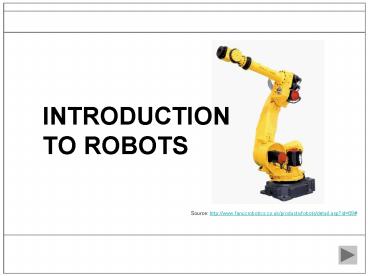INTRODUCTION TO ROBOTS - PowerPoint PPT Presentation
1 / 13
Title:
INTRODUCTION TO ROBOTS
Description:
... robots of the movies, such as C-3PO and the Terminator are portrayed as ... Today, we find most robots working for people in factories, warehouses, and ... – PowerPoint PPT presentation
Number of Views:111
Avg rating:3.0/5.0
Title: INTRODUCTION TO ROBOTS
1
INTRODUCTION TO ROBOTS
Source http//www.fanucrobotics.co.uk/products/ro
bots/detail.asp?id89
2
INTRODUCTION
- The robots of the movies, such as C-3PO and the
Terminator are portrayed as fantastic,
intelligent, even dangerous forms of artificial
life. - Today, we find most robots working for people in
factories, warehouses, and laboratories. In the
future, robots may show up in other places our
schools, our homes, even our bodies. - Robots have the potential to change our economy,
our health, our standard of living, our knowledge
and the world in which we live.
Source www.terminator3.com
3
ROBOT BASICS
- Most robots are designed to be a helping hand.
They help people with tasks that would be
difficult, unsafe, or boring for a real person to
do alone. - At its simplest, a robot is machine that can be
programmed to perform a variety of jobs, which
usually involve moving or handling objects.
Robots can range from simple machines to highly
complex, computer-controlled devices.
Source http//www.robotics-technology.com/robots
/fanuc/index.html
4
TODAYS APPLICATIONS
- 90 of all robots used today are found in
factories. These kind of robots are referred to
as industrial robots. Although many kinds of
robots can be found in manufacturing today,
jointed arm robots are particularly useful and
common. - Ten years ago, 9 out of 10 robots were being
bought by auto companies - now, only 50 of
robots made today are bought by car
manufacturers. - Robots are slowly finding their way into
warehouses, laboratories, research and
exploration sites, energy plants, hospitals, even
outer space.
Source www.robotics-technology.com/robots/abb/ind
ex.html
5
WHY ROBOTS?
- Robots are useful in industry for a variety of
reasons. In today's economy, a business needs to
be efficient to keep up with the competition.
Installing robots is often a way business owners
can be more competitive, because robots can do
some things more efficiently than people. - Robots never get sick or need to rest, so they
can work 24 hours a day, 7 days a week. - When the task required would be dangerous for a
person, they can be do the work instead. - Robots don't get bored, so work that is
repetitive and unrewarding is no problem for a
robot.
Source http//www.robotics-technology.com/robots
/fanuc/index.html
6
EVERYDAY ROBOT TASKS
- Although robots can't do every type of job, there
are certain tasks robots do very well - Assembling products
- Handling dangerous materials
- Spraying finishes
- Inspecting parts, produce, and livestock
- Cutting and polishing
Source http//www.robotics-technology.com/robots
/staeubli/index.html
7
5 MAIN PARTS
- For a machine to qualify as a robot, it usually
needs these 5 parts - Controller
- Arm
- Drive
- End Effector
- Sensor
Source http//www.thetech.org/exhibits_events/on
line/robots/5main/5main.html
8
CONTROLLER
- Every robot is connected to a computer, which
keeps the pieces of the arm working together.
This computer is known as the controller. - The controller functions as the "brain" of the
robot. The controller also allows the robot to be
networked to other systems, so that it may work
together with other machines, processes, or
robots.
Source http//www.thetech.org/exhibits_events/on
line/robots/5main/5main.html
9
ARM
- Robot arms come in all shapes and sizes. The arm
is the part of the robot that positions the
end-effector and sensors to do their
pre-programmed business. - Many (but not all) resemble human arms, and have
shoulders, elbows, wrists, even fingers. This
gives the robot a lot of ways to position itself
in its environment. Each joint is said to give
the robot 1 degree of freedom.
Source http//www.thetech.org/exhibits_events/on
line/robots/5main/5main.html
10
DRIVE
- The drive is the "engine" that drives the links
(the sections between the joints into their
desired position. Without a drive, a robot would
just sit there, which is not often helpful. Most
drives are powered by air, water pressure, or
electricity.
Source http//www.thetech.org/exhibits_events/on
line/robots/5main/5main.html
11
END - EFFECTOR
- The end-effector is the "hand" connected to the
robot's arm. It is often different from a human
hand - it could be a tool such as a gripper, a
vacuum pump, tweezers, scalpel, blowtorch - just
about anything that helps it do its job. Some
robots can change end-effectors, and be
reprogrammed for a different set of tasks. - If the robot has more than one arm, there can be
more than one end-effector on the same robot,
each suited for a specific task.
Source http//www.thetech.org/exhibits_events/on
line/robots/5main/5main.html
12
SENSOR
- The sensor sends information, in the form of
electronic signals back to the controller.
Sensors also give the robot controller
information about its surroundings and lets it
know the exact position of the arm, or the state
of the world around it.
Source http//www.thetech.org/exhibits_events/on
line/robots/5main/5main.html
13
DEGREES OF FREEDOM
- In order to reach any possible point in space
within its work envelope, a robot needs a total
of 6 degrees of freedom. Each direction a joint
can go gives an arm 1 degree. As a result, many
robots of today are designed to move in at least
6 ways. - Some robots have 8, 12, or even 20 degrees of
freedom, but these 6 are enough for most basic
tasks. As a result, most jointed-arm robots in
use today have 6 degrees of freedom.
Source http//www.thetech.org/exhibits_events/on
line/robots/5main/5main.html























![Surgical Robots Market Innovations in Healthcare Sector to Give Exponential Growth [2020-2028] PowerPoint PPT Presentation](https://s3.amazonaws.com/images.powershow.com/9678781.th0.jpg?_=20211101014)







